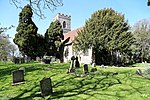Hatfield Regis Priory
1135 establishments in England1536 disestablishments in EnglandBenedictine monasteries in EnglandChristian monasteries established in the 12th centuryHatfield Broad Oak ... and 2 more
History of EssexMonasteries in Essex

Hatfield Broad Oak Priory, or Hatfield Regis Priory, is a former Benedictine priory in Hatfield Broad Oak, Essex, England. Founded by 1139, it was dissolved in 1536 as part of Henry VIII's dissolution of the monasteries.
Excerpt from the Wikipedia article Hatfield Regis Priory (License: CC BY-SA 3.0, Authors, Images).Hatfield Regis Priory
High Street, Uttlesford Hatfield Broad Oak
Geographical coordinates (GPS) Address Nearby Places Show on map
Geographical coordinates (GPS)
| Latitude | Longitude |
|---|---|
| N 51.82781 ° | E 0.24271 ° |
Address
High Street
CM22 7HG Uttlesford, Hatfield Broad Oak
England, United Kingdom
Open on Google Maps









